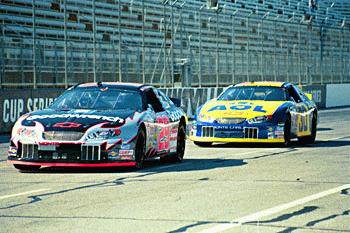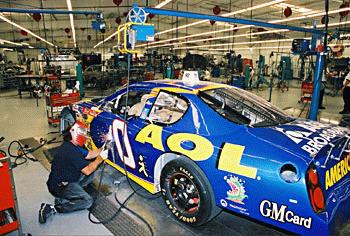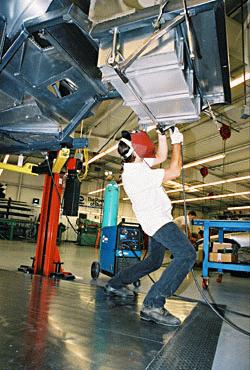Richard Childress Racing (RCR) depends on Miller products to keep their NASCAR drivers on track.
When talk turns to legendary stock car racing teams, for many fans, the conversation begins and ends with Richard Childress Racing (RCR) and the late Dale Earnhardt Sr. driving his famed #3 to seven Winston Cup Series championships during their successful, nearly 20-year association.
Despite Earnhardt's untimely death in 2001, Richard Childress Racing continues to be a major player in NASCAR racing competition. But then the racing industry and its followers have come to expect nothing less than excellence from Childress. When he drove his own Winston Cup car from 1969 to 1981, Childress recorded six top-five and 76 top-10 finishes. He finished fifth in point standings in 1975 and won top-10 point finishes in five of the eight seasons he competed as a driver.
 |
|
Drivers Kevin Harvick #29 and Dave Blaney #30 race for Richard Childress Racing (RCR) of Welcome, N.C. They depend on Miller welding products to keep their cars in top shape.
|
As an owner, Childress became the first to win championships in the Winston Cup, Busch Grand National and Truck Series, earning more than 100 victories along the way. Childress's current drivers include Kevin Harvick #29, Dave Blaney #30, Robby Gordon #31, Ron Hornaday #2 and Clint Bowyer #21.
Miller Equipment Dependable
The shop floors at RCR feature Miller's Dynasty 300 DX AC/DC and Syncrowave TIG power sources, Millermatic 210 MIG welding machines, Swingarc boom- mounted versions of Miller's 60 and 70 series wire feeders paired with CP-302 MIG power sources, and a Spectrum 2050 air plasma cutting system.
Adam Meyer, manager of RCR's chassis and fabrication operation, supervises a beehive of activity in his shop as cars in various stages of fabrication vie for the attentions of his crewmembers. There are checklists to follow, schedules to maintain and deadlines to meet as cars roll from one area to another, while anxious crew chiefs check on the progress of cars they want back out on the oval track.
The action in the shops is almost as fast-paced as on the track. "It takes us about 12 days to hang a body on a completed chassis. We've done it as fast as five, but generally it takes 12 days," Meyer says. Breakdowns and delays are viewed as unwelcome intruders in both venues. And that's why dependability and reliability are the watchwords of the day, and every day, in Meyer's shop.
 |
|
RCR operator, Pete Yankopoulos, uses Miller's CP-302 power source and Swingarc boom to make spot weld repairs to RCR's AOL car hit in the side during a recent race.
|
When he talks about reliable equipment, Meyer points to the Dynasty 300 DXs and CP-302s scattered around his shop. "They're really cool machines because they fit our specialized needs and they give us the kind of precision and accuracy that this business demands," he says. "And they never give us any problems."
"We do a lot of tack welding and we can fine-tune the power source to where it works really well," Meyer says. "The exterior sheet metal is .024 gauge steel and we tack them every 1-1/4 inch on the side and every 1 inch on top of the fenders. All the sheet metal is just tack welded. There are thousands of tack welds on a car - I'd hate to have to count them. The CP-302s' three-phase input power just gives it a little bit more heat to start with, more initial heat than a regular single-phase machine. It just works really well."
With thousands of tack welds per car, and the resulting stops and starts, the CP- 302s provide the kind of excellent arc starts that enhance productivity and help maintain tight work schedules. A lesser machine could start to develop contactor problems or would need to be rotated out faster because it wears out.
Millermatic 210 Faster
Meyer's shop has eight surface plates, which are 8-foot by 20-foot, 1-1/2-inch thick steel platforms that provide a flat surface workstation for crews working on cars. RCR purchases raw chassis from Ronnie Hopkins in South Carolina. "When a chassis comes in, we have to mount the motor, the seat, the pedals, exhaust, oil coolers, oil tank, fuel cell, front and rear shocks, among other things. Sometimes we have to move the pivot points under the front suspension to suit a crew chief. The car spends a week back here and then it goes back to the Cup shop where they'll bolt all the suspension underneath it. It will actually have the rear housing, all four wheels, and it will roll into the other part of the shop, where it takes us 12 days to hang a body on it," Meyer says.
The Millermatic 210 all-in-one MIG welder is used for chassis preparation, including welding on all the motor mounts, shock brackets, fuel cell cans, track bar mounts and sway bar mounts. "We use the Millermatic because it's fast and productive, which is a critical factor for us when we have crews waiting to get their cars out on the race track," Meyer says.
 |
|
Fabricator Ray Bolen prefers the Millermatic 210 MIG because it's handy for those out-of-position welds when the car is on a lift.
|
"In addition, a MIG welder is easier to use for those out-of-position welds," Meyer says. "Sometimes we have to weld while the car is up on a lift. Whereas with a TIG welder you have to use a foot pedal, with a MIG welder you just use a spool gun and you can work overhead or while laying inside the car doing the inside sheet metal work."
Ray Bolen, an RCR operator, says the key to a good MIG arc start is "clipping the wire at a 45 degree angle so that the wire is starting at a smaller size than it actually is. We use .035 wire on all of our cars, and if you try to start it with a blunt end, no machine will start all that well. In fact, no matter what type of machine it is, it won't start as well. So an experienced MIG welder will always clip his wire at 45 degrees for a good start every time."
TIG Has a Role
TIG welding also has its place in Meyer's shop because so much thin-gauge aluminum is used. Among the many items fabricated in Meyer's shop is the cold air box, which basically is the air cleaner for the racecar.
The base is spun aluminum and the thickness ranges from .040 to .060 at the thickest part. This is where the Dynasty 300 DX is called on to perform its magic. The Dynasty's advanced squarewave technology stabilizes the arc on low power for improved weldability on aluminum. Extended balance control allows the operator to fine-tune duration of the electrode negative portion of cycle from 30 percent to 99 percent. Operators also have a frequency adjustment from 20 to 250 Hz, giving precise cleaning, control and prolonged tungsten life. Balance control and frequency were set at 65 and 120.
"Because we're working on a lot of thinner materials - as many fabrication shops do - we like a tighter arc. The Dynasty provides control for a focused arc and that lets our operators put it where they need it," says Gavin Kober, an operator. "With this thinner material, that's critical. With a real wide arc, you tend to burn a lot more of the material away, and you can't direct the weld where you want it."
The Dynasty also is used to weld oil pans together and weld handles on the refueling gas tanks used by pit crews. Meyer's crews have learned from experience that for maximum arc performance, they use 2 percent ceriated tungsten kept to a point. "The Dynasty operates at peak arc efficiency if you keep your tungsten very sharp," he says.
In addition to using TIG for welding aluminum because of its precision and accuracy, Meyer says there's another reason: "It gives us a prettier looking weld. When you've got $3 million to $10 million race car sponsors, they want their stuff to look nice."
Swingarc Boom Helps
Activity in Meyer's shop slips into high gear when his crews have to work on a car that was wrecked in a crash. "Naturally, the crew chiefs want to get their cars back in operation as quickly as possible - sometimes within a day. So we need to be as efficient and productive as we can," he says.
That's when Miller's Swingarc boom-mounted wire feeders swing into action. "We have 10 different booms here and they're really cool because we don't have to roll the welding machines around," Meyer says. "When we have to fix a wreck quickly, we can swing two or three booms all around the car if we have to. It saves all kinds of time."
The Swingarc places the feeder controls at the base of a 16-foot boom and the drive assembly at the end of the boom. The boom rotates 360 degrees and moves 60 degrees up and down to create a 32-foot diameter work area. A counterbalance design holds the boom in place once the operator sets its position.
And speaking of wrecks, that's where Miller's Spectrum 2050 air plasma cutting system comes in handy. "Before we send the car to get a front clip or a rear clip on it, we'll take the plasma cutter and cut off all the parts that are too damaged to use again.
We prefer the plasma cutter to a cut-up wheel or oxyfuel cutter because it's cleaner and faster. You take the plasma cutter and you zip it off and you're done," Meyer says. "We work in many tight areas and a flame torch is not good for accessing those areas. But you can get the plasma torch in a lot easier."
RCR has depended on Miller Electric equipment for years. "Back in that corner we've still got a Millermatic 200 on one side and a Syncrowave 300 on the other side. The Millermatic 200 has been chugging along since 1991 and the Syncrowave 300 is from 1985 and still going strong. That says it all, doesn't it?" Meyer says.